Arturas Bukauskas is a Doctor of Arts and an Associate Professor at the Department of Photography, Animation, and Media Arts, Vilnius Academy of Arts. His background is in documentary film directing. His artistic interests include the intersections of living and non-living entities within societal constructs, along with their corresponding concepts and transformations. He works with experimental forms of the moving image and explores the interactions between text and image. He investigates the aesthetic and conceptual expressiveness of technology-based art, with a particular research focus on the phenomenon of animation.
[→] "Unbind him and let him go". TITANIKAS Galery. Vilnius, Lithuania, Feb. 15 - Mar. 14, 2024
[→] Spare parts for Theseus plane. Jonas Mekas Visual Arts Center. Vilnius, Lithuania, Jun. 23 - Jul. 15, 2023
[→] Collective exhibition "PR(O) _reGRESS". FUTUR21. Object "Erzatszteile für das Schiff des Theseus?". installation in the former ship elevator industrial museum, on the ship - in the OSTARA gallery. Heinrichenburg, Germany, Mar. 26 - Apr. 2, 2022
[→] Duo exhibition "Arturas Bukauskas/Andrius Sarapovas - a line running on both sides of sea level", ARTIFEX gallery, Vilnius, Lithuania, Feb. 23 - Mar. 10, 2022
[→] Audiovisual project "Women's portraits". Joana Gedmintaitė (soprano), Eglė Kasteckaitė (piano), Vilnius Choral Singing School choir "Liepaitės", actress Nelė Savičenko. Video projections. Vilnius, Apr. 29, 2014. Klaipėda, May 21, 2014
[→] "Myth no. 688E" 2 audiovisual texts for G. Sviderskytė's research "Lituanica documentica". Vilnius, Jan. 2013
[→] Loreta Narvilaitė "Liūdesio Sodai" - ensemble "Giunter Percussion". Video projection. "Young Music" festival. Klaipeda. May 7, 2010
[→] Duo Strimaitis music and video performance "Night music". Video installations. Festival "Music of Change". Klaipeda. November 10, 2009 (April 11, 2009. City Hall Vilnius, Kėdainiai). in the expanded field Gallery "Titanikas", Vilnius. May 4 - 16, 2018.
[→] "ArtVilnius 2019". 10th International Contemporary Art Fair, Titanic Exposition. May 29 - Jun. 2, 2019. TOP 7 best galleries award. The main audience award.
[→] "Eikasia", Exhibition of Virtual Reality and Media Art. St. Gallery of the Church of Our Lady of Peace, Vilnius. May 13 - 26, 2019
[→] "Anima(re)anima in the expanded field". Gallery "Titanikas", Vilnius. May 4 - 16, 2018.
THE LAST SUNDAY OF AUGUST
documentary/animated. Israel. Animation editing direction, 2017
PRACTICAL TRAINING ON HUMAN SUBJECT
live action, 3D animation, 11 min, 2007
ESTETOMOTTO
live action, 3D animation, 16 min, 2005
EROTOMOTTO
live action, 3D animation, 9 min, 2005,
A DAY OF BIRDS
animation, 2 min, 2d multimedia, international project "Optimus Mundis", 1998
PLAY fiction
40 min, 35 mm, 1995
A LULLABY FOR THE CITY
animation, 3 min, 2d multimedia, 1995
A TELEPHONE LINE
animation, 5 min, 35 mm, 1991
More than 30 video adds and short films. Film director, audiovisual post-production supervisor.
Bukauskas, A. (2023). Mirksi žymeklis. Pavadinimo vietoje – ne iki galo surinktas tekstas. „Jie atgijo”... Apie rekursinę animaciją.” Dailė, (90), ISSN 0130-6626
Bukauskas, A. (2022). Menama nukritusio lėktuvo ir lakūno kūnų sueitis (materijos reginiai). Acta Academiae Artium Vilnensis, (106), 302–321. https://doi.org/10.37522/aaav.106.2022.128
Bukauskas, A. (2021). Virtualios realybė kaukė. Technologijos ir menas.Tyrimai ir aktualijos, (12), 94–98.
Bukauskas, A. (2011). Ritualinis laiko aukojimas. Kultūra ir menas (temų konspektai). Vilnius: Lodvila.
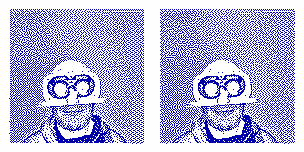
Vilnius Academy of Arts
Phd of Art
VGIK, Russian Academy of Cinema (Всероссийский Государственный Институт Кинематографии)
M.A., Department of film directing, documentary film directing
V. Kobrin’s class
Vilnius University
M.A., Faculty of Physics, Radiophysics
"ALTERNATIVE SCREEN" film studio
Screenwriter, film director
Animation department, Lithuanian Film Studio
Film director, screenwriter, animator
Vilniaus Academy of Art
Department of Photography and Media Arts
Associate Professor
Lithuanian Academy Of Music And Theatre
Faculty of theatre and film
Lecturer⠀⠀⠀⠀⠀⠀⠀⠀⠀
#
# *** WARNING - DO NOT EDIT OR IN ANY WAY CHANGE THIS FILE!!! ***
#
# Revision History:
#
# 4-14-1996 v1.0 - Verified by UCALC 2.01 - based on
# MIDPAT 2.0 patch list
#
#Explanation of Columns: Patch # 256K 512K 768K 1024K Patch Name
#
0, 2, 2, 0, 0, acpiano
1, 128, 128, 128, 128, britepno
2, 128, 128, 128, 128, synpiano
3, 128, 128, 128, 128, honky
4, 2, 2, 0, 4, epiano1
5, 128, 128, 128, 128, epiano2
6, 128, 128, 128, 128, hrpschrd
7, 7, 7, 7, 7, clavinet
8, 12, 12, 12, 8, celeste
9, 128, 128, 128, 128, glocken
10, 12, 12, 12, 8, musicbox
11, 128, 128, 128, 128, vibes
12, 12, 12, 12, 12, marimba
13, 12, 12, 12, 12, xylophon
14, 12, 14, 14, 14, tubebell
15, 128, 128, 128, 128, santur
GRAPHICS: [ ] SVGA [ ] VGA [ ] EGA [ ] Other:__________________________
COMPUTER: [ ] P6/686 [ ] PENTIUM/586 [ ] 486 [ ] Other:________________
SOUND CARD: [ ] Sound Blaster & Pro [ ] SB 16 [ ] SB AWE 32 [ ] Ad Lib
[ ] PAS 16 [ ] GUS [ ] None [ ] Other:_____________________
--- continued ---
# __ __ __ __ __ __ __ __ # | \ | \ | \ | \ | \ | \ | \ | \ # | $$ | $$ _______ | $$____ \$$ _______ ____| $$ | $$____ \$$ ______ ____ ______ _______ ____| $$ # | $$ | $$| \ | $$ \ | \| \ / $$ | $$ \ | \| \ \ | \ | \ / $$ # | $$ | $$| $$$$$$$\| $$$$$$$\| $$| $$$$$$$\| $$$$$$$ | $$$$$$$\| $$| $$$$$$\$$$$\ \$$$$$$\| $$$$$$$\| $$$$$$$ # | $$ | $$| $$ | $$| $$ | $$| $$| $$ | $$| $$ | $$ | $$ | $$| $$| $$ | $$ | $$ / $$| $$ | $$| $$ | $$ # | $$__/ $$| $$ | $$| $$__/ $$| $$| $$ | $$| $$__| $$ | $$ | $$| $$| $$ | $$ | $$ | $$$$$$$| $$ | $$| $$__| $$ # \$$ $$| $$ | $$| $$ $$| $$| $$ | $$ \$$ $$ | $$ | $$| $$| $$ | $$ | $$ \$$ $$| $$ | $$ \$$ $$ # _\$$$$$$ \$$ __\$$ \$$$$$$$__\$$ \$$ __\$$ \$$$$$$$ \$$ \$$ \$$ \$$ \$$ \$$ \$$$$$$$ \$$ \$$ \$$$$$$$ # | \ | \ | \ | \ # | $$ ______ _| $$_ | $$____ \$$ ______ ____ ______ ______ # | $$ / \ $$ \ | $$ \ | \| \ \ / \ / \ # | $$| $$$$$$\$$$$$$ | $$$$$$$\| $$| $$$$$$\$$$$\ | $$$$$$\| $$$$$$\ # | $$| $$ $$| $$ __ | $$ | $$| $$| $$ | $$ | $$ | $$ | $$| $$ | $$ # | $$| $$$$$$$$| $$| \ | $$ | $$| $$| $$ | $$ | $$ | $$__| $$| $$__/ $$ # | $$ \$$ \ \$$ $$ | $$ | $$| $$| $$ | $$ | $$ \$$ $$ \$$ $$ # \$$ \$$$$$$$ \$$$$ \$$ \$$ \$$ \$$ \$$ \$$ _\$$$$$$$ \$$$$$$ # | \__| $$ # \$$ $$ # \$$$$$$
"Unbind him and let him go"
Feb. 15 - Mar. 9, 2024
TITANIKAS Galery
Photo documentation
Imagine that an as yet unknown technology enables us to resurrect anything: any being, any age, any state of the world. Knowledge of the fundamental physical and metaphysical laws as well as comprehensive data on the evolution of the universe until this point should allow a precise reconstruction of any process of emergence or disappearance that constituted it. Animating unlived time and decomposed space, at least as a projection or simulation, has become a shared fantasy, a readily recognisable register of moving and still images. The ultimate expression of our representational curiosity; what beguiles us most is not what mechanical image recording devices can or could capture, but what took place before their invention (in other words, not in our habitual reality). Bringing that back to life requires an algorithm – a text in the broadest sense, a prompt describing what we desire to see. Hence, image becomes arbitrary and abstract, no matter what its particular content is. The essential thing is that such an image is possible in principle, even if no consciousness presently alive has ever seen it with its own eyes, and its source or prototype is unidentifiable. Just like sound, image can be acousmatic, emanating from an invisible source – from a sinkhole, a cavity, from beneath the surface, among the debris of what once was. What we see and hear is inevitably ghostlike. The image is finally unbound, unwrapped from the shroud of spacetime, empowered to rise from the catacomb and go in any direction. It has ceased to refer to anything conventionally perceived as real, but it is alive in an as yet unfamiliar sense, because someone recognised it as such. Yet no resurrection happens without entropy and danger to its witness. What comes back is not exactly the same as what was intended to be reanimated, if not its absolute opposite – an otherworldly entity that refuses to return to the ground and threatens the integrity of the viewer’s self-consciousness. Even with this risk in mind, though, the power to unbind (image, sound, gaze, time) and let go is too tempting. That is when they come to life and begin to rush to the surface – or inside. The viewer can only let themselves be devoured and see where it leads.
Text: Jurij Dobriakov
Architecture: Mindaugas Reklaitis
Sound: Benas Buivydas
____ ____ _ ____ _____ ____ _ ____ _____ ____ _____ ___ ____ / ___|| _ \ / \ | _ \| ____| | _ \ / \ | _ \_ _/ ___| | ___/ _ \| _ \ \___ \| |_) / _ \ | |_) | _| | |_) / _ \ | |_) || | \___ \ | |_ | | | | |_) | ___) | __/ ___ \| _ <| |___ | __/ ___ \| _ < | | ___) | | _|| |_| | _ < |____/|_| /_/ \_\_| \_\_____| |_| /_/ \_\_| \_\|_| |____/ |_| \___/|_| \_\ _____ _ _ _____ ____ _____ _ _ ____ ____ _ _ _ _ _____ |_ _| | | | ____/ ___|| ____| | | / ___| | _ \| | / \ | \ | | ____| | | | |_| | _| \___ \| _| | | | \___ \ | |_) | | / _ \ | \| | _| | | | _ | |___ ___) | |___| |_| |___) | | __/| |___ / ___ \| |\ | |___ |_| |_| |_|_____|____/|_____|\___/|____/ |_| |_____/_/ \_\_| \_|_____|


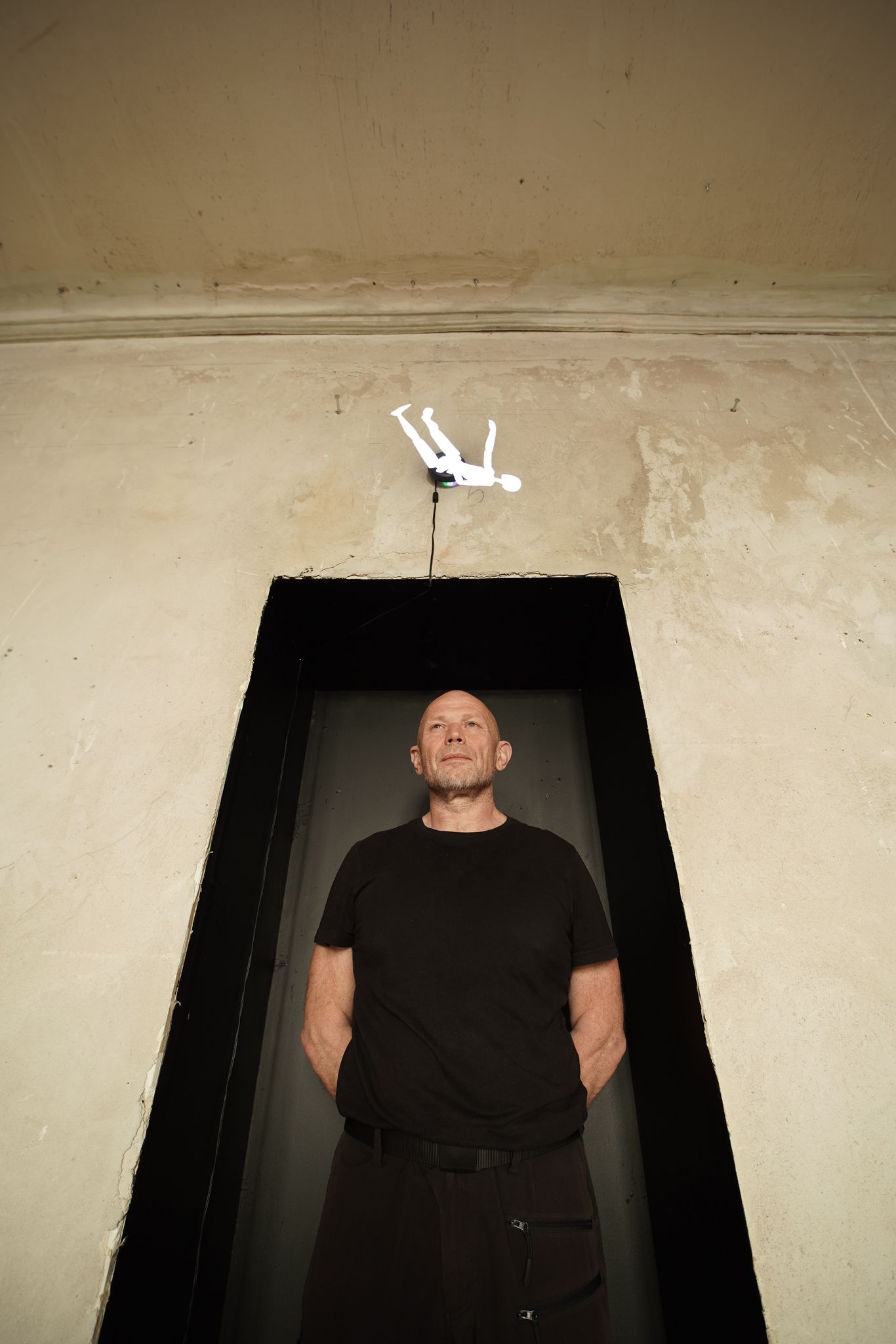
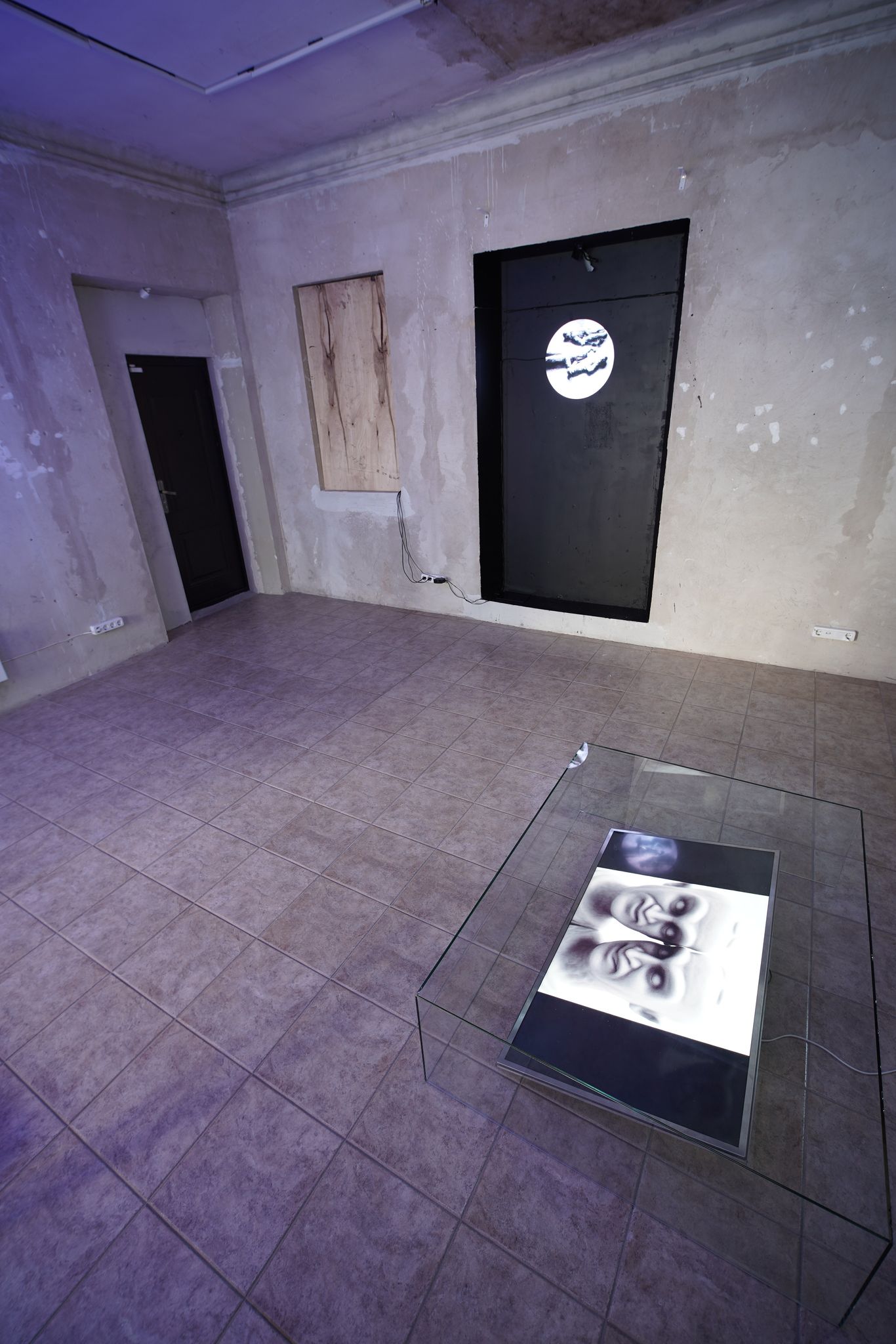
SPARE PARTS FOR THESEUS PLANE
Arturas Bukauskas
2023
In 1933, aviators Darius and Girėnas flew from New York to Kaunas. They flew a modified experimental aircraft named Lituanica. They wanted to make Lithuania famous with this flight. The plane crashed in Germany, just a short distance from its destination. The bodies of the aviators were embalmed and kept in a mausoleum. When the war started, they were hidden in the wall of the Kaunas Medical Institute. After the war, nothing was known about their hiding place. Thirty years after the air crash, the grown-up daughter of one of the aviators, now a doctor, used her percussion method to search for cavities in the walls. That's how she found her father.
This exhibition is the third and final of a composition of three exhibitions. The series of exhibitions based on the principle of Theseus's ship (plane) deals with the question of the continuity of the body and memory.
In the third exhibition, the same parts, understood both as spare parts and as wrecks, are described and multiplied by means of prompt engineering (human language for machines). One could say that the works remain "behind and after" all three exhibitions because, according to Theseus' paradox, they find and pass into each other, animate, and become unnameable as they come to life. They are neither the fragments of a plane, nor the parts, nor the bodies of pilots. The catastrophe has not happened, it has only been approached, only the rough connections between the still falling parts and the human body that has reached the limit of time are observed.
_| _|
_|_|_| _|_|_| _| _|_| _| _|_|_| _|_|_| _|_|_|_| _|_|_| _|_|_|
_| _| _| _| _| _| _| _| _| _|_| _|_| _| _| _| _| _| _|
_|_|_| _|_|_| _| _| _| _| _|_| _|_|_|_| _| _|_| _|_|_| _|_|_| _|_| _|_|
_| _| _| _| _| _| _| _| _| _| _| _| _| _| _| _|
_| _| _| _| _|_| _| _| _|_|_| _|_|_| _| _| _|_|_|_| _|_|_| _|_|_|
_| _|
_|_|_|_|_|
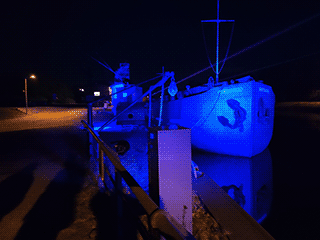
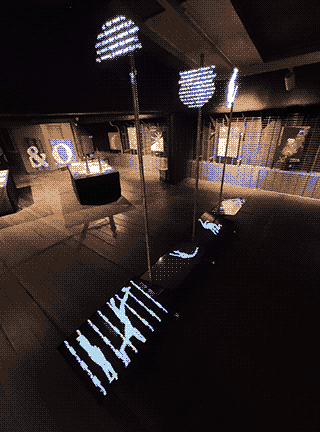
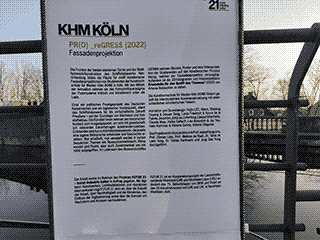
Ersatzteile für das Schiff des Theseus?
Arturas Bukauskas
2022
Zu sehen ist außerdem die Arbeit Ersatzteile für das Schiff von Theseus (2022) von Arturas Bukauskas. In seiner 3D-Hologramm- und Videoinstallation denkt der Künstler darüber nach, wie Körperbewegungen und Handlungen durch neue Technologien beeinflusst werden.
Auf mehreren Monitoren sind abstrakte Oberflächen in Bewegung zu sehen, die sich scheinbar im Widerstreit befinden. Dazu zeigen drei 3D-Hologramme Worte, die von einer künstlichen Intelligenz generiert wurden. Es handelt sich um Wortneuschöpfungen für menschliche Tätigen, die es noch nicht gibt und die vielleicht erst in Zukunft durch neue Erfindungen möglich sein werden.
Die Installation fragt, ob wir durch zukünftige Werkzeuge bald Tätigkeiten verrichten können, die uns heute noch unmöglich, gar paradox erscheinen.
___ __ __ _ __ _____ ___ ___ ___ __ _ _ __ _____ __
/ _/ / // / /// //_ _// _/ / o.) / _/,'_/ .' \ / |/ //_ _// /
/ _/ / // /_/ U / / / / _/ / o \ / _// /_n / o // || / / / / /
/___//_//___/\_,' /_/ /___/ /___,'/___/|__,'/_n_//_/|_/ /_/ /_/

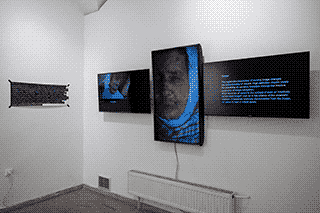

“a marque scrolling on both sides of sea level"
Bukauskas:
The ship and plane of Theseus. The Theseus ship paradox raises raises the question whether a ship which has had all of its parts gradually replaced remains the same ship. The plane of Theseus is an object whose parts have been replaced on the ground, then in the air, during the fall, then on the ground again, with numerous rearrangements of the crash site and stuffed dummies of the pilots. The question is whether we are a part of this plane, and perhaps an already replaced one. How are the functions of memory redistributed in a body that expires? How does memory reorganise those functions in movements? Can a shared reminiscence be triggered by an external action? An accident is constantly materialised by motion, while every moved object is a projection of an accident. The exhibition features bodies (like computer storage media undergoing defragmentation) that have ceased resisting both the external gaze and the attempts to provide care to them. Bodies as the totality of replaceable parts. Bodies which, when moved, remind of the possibility of unfinished actions. The question of truth is irrelevant, because the real is no longer confined to the bodily senses. The position of a contemporary artist that is reconsidered in the exhibition is also no longer any bodily position – the artist has come to the store and forgot the shopping list. The intention was to copy the actions of buying, to pretend to act against them, in a politically and socially active way – and instead the artist froze. The viewer is invited to be a witness to that and to date (as in dating, i. e. making obsolete over time) together. A few actions remain relevant. ‘Can you really use a spoon though?’
Šarapovas:
Every sound is a small earthquake. Or not so small. The aural environment – the vehicle of tactile memory – is experienced as a very real and tangible yet also somewhat spectral manifestation of the past reality. The listener perceives sound as their present; sound testifies: these are incidents of temporal reality, I reproduce them in your surfaces. The world also experiences your presence in the sea of air as sound. It says: I am Sisyphus, a swarm of small Sisyphi; and immediately pretends to be null, an invariable repetition, a loop. Helmholtz takes a knife and divides a circle into two equal parts. That is how the sine wave, the mother of all sounds, is born. Mare Memoria, the sea of memory, is the movement of molecules in liquids, gases and solid bodies, waves constantly rolling on the shore of the listener’s ear, rubbing stories of ever new catastrophes into their cochlea.
A second-long sound cycle – one ascent and one descent of the sine wave – travels 343 metres in air at 20°C and moderate humidity at sea level.
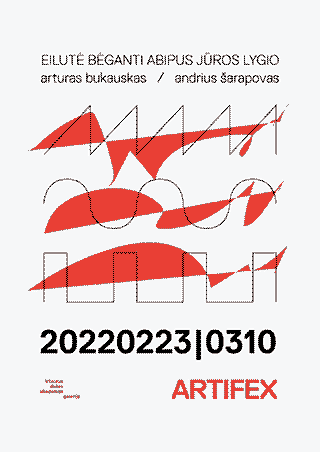
[menu]
menuitem=CD, Start computer with CD-ROM support.
menuitem=NOCD, Start computer without CD-ROM support.
menuitem=HELP, View the Help file.
menudefault=CD,30
menucolor=7,0
[CD]
device=himem.sys /testmem:off
device=oakcdrom.sys /D:mscd001
device=btdosm.sys
device=flashpt.sys
device=btcdrom.sys /D:mscd001
device=aspi2dos.sys
device=aspi8dos.sys
device=aspi4dos.sys
device=aspi8u2.sys
device=aspicd.sys /D:mscd001
[NOCD]
device=himem.sys /testmem:off
[HELP]
device=himem.sys /testmem:off
[COMMON]
files=10
buffers=10
dos=high,umb
stacks=9,256
devicehigh=ramdrive.sys /E 2048
lastdrive=z
device=display.sys con=(ega,,1)
country=370,775,country.sys
install=mode con cp prepare=((775) ega3.cpi)
install=mode con cp select=775
menuitem=CD, Start computer with CD-ROM support.
menuitem=NOCD, Start computer without CD-ROM support.
menuitem=HELP, View the Help file.
menudefault=CD,30
menucolor=7,0
[CD]
device=himem.sys /testmem:off
device=oakcdrom.sys /D:mscd001
device=btdosm.sys
device=flashpt.sys
device=btcdrom.sys /D:mscd001
device=aspi2dos.sys
device=aspi8dos.sys
device=aspi4dos.sys
device=aspi8u2.sys
device=aspicd.sys /D:mscd001
[NOCD]
device=himem.sys /testmem:off
[HELP]
device=himem.sys /testmem:off
[COMMON]
files=10
buffers=10
dos=high,umb
stacks=9,256
devicehigh=ramdrive.sys /E 2048
lastdrive=z
device=display.sys con=(ega,,1)
country=370,775,country.sys
install=mode con cp prepare=((775) ega3.cpi)
install=mode con cp select=775
4d5a 5100 0b00 0600 0400 063d ffff 073e
0004 0000 0000 0000 1c00 0000 0100 0000
4303 0c01 4503 0c01 4703 0c01 4903 0c01
4b03 0c01 0000 0000 0000 0000 0000 0000
b80c 018e d88e c0fc 32e4 cd1a 80e6 7f89
165d 03b8 1300 cd10 33c0 cd33 3dff ff0f
9406 5b03 be0a 02fa bac8 0332 c0ee 42b9
0003 f36e fb8e 263d 0364 c606 fff9 6064
c606 fef9 6064 c606 fdf9 6064 c606 bdf8
6064 c606 7df7 6064 c606 7ef7 6064 c606
7ff7 6064 c606 7bf7 6064 c606 7af7 6064
c606 79f7 6064 c606 baf8 6064 c606 faf9
6064 c606 f9f9 6064 c606 77f7 6064 c606
76f7 6064 c606 75f7 6064 c606 b6f8 6064
c606 f6f9 60e8 4b00 e8a8 00c6 065f 0300
c706 5103 e803 c706 5303 e803 e849 03e8
9703 e85a 09be aa07 8e06 3d03 bf20 00b3
c8b9 4000 f366 a583 c740 fecb 75f3 8e06
4503 803e 5f03 0074 d3b8 0300 cd10 b800
4ccd 218e 064b 0333 ff66 b8ff ffff ffb9
0040 f366 abb8 ab00 f726 5d03 05cd 2b83
d200 f736 4d03 8916 5d03 8bf2 26c6 0600
0000 26c6 0680 00fe 26c6 0600 80fe 26c6
0680 8000 6a00 6800 01e8 dd00 83c4 0433
ff26 8a05 c0e8 0304 40aa 0bff 75f3 8e06
4503 c38e 0647 038e 2649 0333 ff66 b8ff
ffff ffb9 0040 f366 abb8 ab00 f726 5d03
05cd 2b83 d200 f736 4d03 8916 5d03 8bf2
26c6 0600 0080 6a00 6800 01e8 8b00 83c4
0433 f68b 3e4f 03c1 e704 8b9d 1f03 268a
0032 e48b 9d21 0326 0200 80d4 008b 9d23
0326 0200 80d4 008b 9d25 0326 0200 80d4
00c1 e802 2688 0446 75d0 33f6 268a 0432
e426 2a44 0380 dc00 0520 0079 0233 c03d
3f00 7603 b83f 0064 8804 4675 df33 f626
8a04 32e4 2602 4401 80d4 0026 0284 0001
80d4 0026 0284 0101 80d4 00c1 e802 2688
0446 75db 8e06 4503 c38b ec8b 5e04 8b4e
02d1 e926 8a17 02d9 8bfb 02d9 2680 3dff
7544 32f6 2602 1780 d600 d1ea 8aea b8ab
00f7 e605 cd2b 83d2 00f7 364d 038b f281
eac2 678a c132 e4f7 ea8a c48a e2c1 f805
9802 c580 d400 7809 3dfe 0076 06b0 feeb
0232 c026 8805 268a 1702 f98b fb02 f926
803d ff75 4432 f626 0217 80d6 00d1 ea8a
eab8 ab00 f7e6 05cd 2b83 d200 f736 4d03
8bf2 81ea c267 8ac1 32e4 f7ea 8ac4 8ae2
c1f8 0598 02c5 80d4 0078 093d fe00 7606
b0fe eb02 32c0 2688 0526 8a17 2ad9 8bfb
2ad9 2680 3dff 7544 32f6 2602 1780 d600
d1ea 8aea b8ab 00f7 e605 cd2b 83d2 00f7
364d 038b f281 eac2 678a c132 e4f7 ea8a
c48a e2c1 f805 9802 c580 d400 7809 3dfe
0076 06b0 feeb 0232 c026 8805 268a 172a
f98b fb2a f926 803d ff75 4432 f626 0217
80d6 00d1 ea8a eab8 ab00 f7e6 05cd 2b83
d200 f736 4d03 8bf2 81ea c267 8ac1 32e4
f7ea 8ac4 8ae2 c1f8 0598 02c5 80d4 0078
093d fe00 7606 b0fe eb02 32c0 2688 0526
8a17 32f6 02d9 02d9 2602 1780 d600 02f9
02f9 2602 1780 d600 2ad9 2ad9 2602 1780
d600 c1ea 028a eab8 ab00 f7e6 05cd 2b83
d200 f736 4d03 8bf2 81ea c267 8ac1 32e4
f7ea 8ac4 8ae2 c1f8 0598 02c5 80d4 0078
093d fe00 7606 b0fe eb02 32c0 02d9 2af9
2688 0780 f901 742f 32ed 2ad9 2af9 5351
e836 fe8b ec8a 4e00 004e 02e8 2bfe 8bec
8a4e 0000 4e03 e820 fe8b ec8a 4e00 284e
02e8 15fe 83c4 04c3 33c9 33d2 33c0 803e
5b03 0074 0eb8 0b00 cd33 5152 b805 00cd
335a 5901 0e51 0329 1653 038b 0e51 038b
1653 0389 0e55 0389 1657 03e8 1e0c 80c4
1973 03b8 ffff a359 03b4 01cd 1674 09c6
065f 0301 32e4 cd16 c3bf aa07 66b9 6300
0000 6633 c0a1 5903 f7d8 c1e8 0305 0040
66c1 e00d 66a3 6003 6633 c0a1 5503 66c1
e009 66a3 6403 6633 c0a1 5703 66c1 e009
66a3 6803 1e8e 2e45 038e 1e4b 0366 65a1
6003 6633 d266 f7f1 6665 8b36 6403 6665
8b2e 6803 662b f066 03e8 66c1 e807 8bde
66c1 ee10 81e6 ff00 66c1 ed08 81e5 00ff
0bf5 668b e866 c1ed 104d a403 d813 f5a4
03d8 13f5 a403 d813 f5a4 03d8 13f5 a403
d813 f5a4 03d8 13f5 a403 d813 f5a4 03d8
13f5 a403 d813 f5a4 03d8 13f5 a403 d813
f5a4 03d8 13f5 a403 d813 f5a4 03d8 13f5
a403 d813 f5a4 03d8 13f5 a403 d813 f5a4
03d8 13f5 a403 d813 f5a4 03d8 13f5 a403
d813 f5a4 03d8 13f5 a403 d813 f5a4 03d8
13f5 a403 d813 f5a4 03d8 13f5 a403 d813
f5a4 03d8 13f5 a403 d813 f5a4 03d8 13f5
a403 d813 f5a4 03d8 13f5 a403 d813 f5a4
03d8 13f5 a403 d813 f5a4 03d8 13f5 a403
d813 f5a4 03d8 13f5 a403 d813 f5a4 03d8
13f5 a403 d813 f5a4 03d8 13f5 a403 d813
f5a4 03d8 13f5 a403 d813 f5a4 03d8 13f5
a403 d813 f5a4 03d8 13f5 a403 d813 f5a4
03d8 13f5 a403 d813 f5a4 03d8 13f5 a403
d813 f5a4 03d8 13f5 a403 d813 f5a4 03d8
13f5 a403 d813 f5a4 03d8 13f5 a403 d813
f5a4 03d8 13f5 a403 d813 f5a4 03d8 13f5
a403 d813 f5a4 03d8 13f5 a403 d813 f5a4
03d8 13f5 a403 d813 f5a4 03d8 13f5 a403
d813 f5a4 03d8 13f5 a403 d813 f5a4 03d8
13f5 a403 d813 f5a4 03d8 13f5 a403 d813
f5a4 03d8 13f5 a403 d813 f5a4 03d8 13f5
a403 d813 f5a4 03d8 13f5 a403 d813 f5a4
03d8 13f5 a403 d813 f5a4 03d8 13f5 a403
d813 f5a4 03d8 13f5 a403 d813 f5a4 03d8
13f5 a403 d813 f5a4 03d8 13f5 a403 d813
f5a4 03d8 13f5 a403 d813 f5a4 03d8 13f5
a403 d813 f5a4 03d8 13f5 a403 d813 f5a4
03d8 13f5 a403 d813 f5a4 03d8 13f5 a403
d813 f5a4 03d8 13f5 a403 d813 f5a4 03d8
13f5 a403 d813 f5a4 03d8 13f5 a403 d813
f5a4 03d8 13f5 a403 d813 f5a4 03d8 13f5
a403 d813 f5a4 03d8 13f5 a403 d813 f5a4
03d8 13f5 a403 d813 f5a4 03d8 13f5 a403
d813 f5a4 03d8 13f5 a403 d813 f5a4 03d8
13f5 a403 d813 f5a4 03d8 13f5 a403 d813
f5a4 03d8 13f5 a403 d813 f5a4 03d8 13f5
a403 d813 f5a4 03d8 13f5 a403 d813 f5a4
03d8 13f5 a403 d813 f5a4 03d8 13f5 a403
d813 f5a4 03d8 13f5 a403 d813 f5a4 03d8
13f5 a403 d813 f5a4 03d8 13f5 a403 d813
f5a4 03d8 13f5 a403 d813 f5a4 03d8 13f5
a403 d813 f5a4 03d8 13f5 a403 d813 f5a4
03d8 13f5 a403 d813 f5a4 03d8 13f5 a403
d813 f5a4 03d8 13f5 a403 d813 f5a4 03d8
13f5 a403 d813 f5a4 03d8 13f5 a403 d813
f5a4 03d8 13f5 a403 d813 f5a4 03d8 13f5
a403 d813 f5a4 03d8 13f5 a403 d813 f5a4
03d8 13f5 a403 d813 f5a4 03d8 13f5 a403
d813 f5a4 03d8 13f5 a403 d813 f5a4 03d8
13f5 a403 d813 f5a4 03d8 13f5 a403 d813
f5a4 03d8 13f5 a403 d813 f5a4 03d8 13f5
a403 d813 f5a4 03d8 13f5 a403 d813 f5a4
03d8 13f5 a403 d813 f5a4 03d8 13f5 a403
d813 f5a4 03d8 13f5 a403 d813 f5a4 03d8
13f5 a403 d813 f5a4 03d8 13f5 a403 d813
f5a4 03d8 13f5 a403 d813 f5a4 03d8 13f5
a403 d813 f5a4 03d8 13f5 a403 d813 f5a4
03d8 13f5 a403 d813 f5a4 03d8 13f5 a403
d813 f5a4 03d8 13f5 a403 d813 f5a4 03d8
13f5 a403 d813 f5a4 03d8 13f5 a403 d813
f5a4 03d8 13f5 a403 d813 f5a4 03d8 13f5
a403 d813 f5a4 03d8 13f5 a403 d813 f5a4
03d8 13f5 a403 d813 f5a4 03d8 13f5 a403
d813 f5a4 03d8 13f5 a403 d813 f5a4 03d8
13f5 a403 d813 f5a4 03d8 13f5 a403 d813
f5a4 03d8 13f5 a403 d813 f5a4 03d8 13f5
a403 d813 f5a4 03d8 13f5 a403 d813 f5a4
03d8 13f5 a403 d813 f5a4 03d8 13f5 a403
d813 f5a4 03d8 13f5 a403 d813 f5a4 03d8
13f5 a403 d813 f5a4 03d8 13f5 a403 d813
f5a4 03d8 13f5 a403 d813 f5a4 03d8 13f5
a403 d813 f5a4 03d8 13f5 a403 d813 f5a4
03d8 13f5 a403 d813 f5a4 03d8 13f5 a403
d813 f5a4 03d8 13f5 a403 d813 f5a4 03d8
13f5 a403 d813 f5a4 03d8 13f5 a403 d813
f5a4 03d8 13f5 a403 d813 f5a4 03d8 13f5
a403 d813 f5a4 fec9 0f85 c1fa 1f66 b850
5050 50b9 4000 f366 ab8b 3659 03d1 ee83
c60a bb04 008b c633 d2f7 f3c1 e807 3d3f
0076 02b0 3f8a e08a d066 c1e0 108a c28a
e0b9 4000 f366 abfe c380 fb2c 75d7 c38e
2647 038e 2e49 0366 b800 7d00 7dbf aa03
b980 00f3 66ab 6633 c0bf aa05 b980 00f3
66ab c706 a003 7800 8b36 a003 8bb4 9001
c1e6 04a1 5703 250f 0034 0f03 f0a1 5903
33d2 f7f6 0564 00a3 a203 6633 c08b c666
c1e0 0666 a3a6 0383 3ea0 0302 750e c706
a203 007d c706 a403 0000 eb0a 33c0 ba01
00f7 f6a3 a403 6633 c98b 0e55 0366 c1e1
0c66 a1a6 0366 c1e0 0766 2bc8 8b16 5703
c1e2 0466 8bd9 66c1 eb10 8afe 8bc6 c1e8
0402 f8d1 e9be fe01 c706 6403 aa07 d1e1
030e a603 121e a803 d1e9 648a 4701 32e4
642a 0780 dc00 f7e9 0fac d007 6402 27f7
26a4 038b 3ea2 032b fa79 03bf ffff 81ff
c800 7c03 bfc7 008b acaa 0389 bcaa 032b
ef0f 8905 05c1 e708 033e 6403 658a 4701
652a 07f6 edd1 e065 0227 8bd0 8784 aa05
502b c299 f7fd 5ad1 e53e ffa6 9001 88b5
0039 03d0 88b5 003a 03d0 88b5 003b 03d0
88b5 003c 03d0 88b5 003d 03d0 88b5 003e
03d0 88b5 003f 03d0 88b5 0040 03d0 88b5
0041 03d0 88b5 0042 03d0 88b5 0043 03d0
88b5 0044 03d0 88b5 0045 03d0 88b5 0046
03d0 88b5 0047 03d0 88b5 0048 03d0 88b5
0049 03d0 88b5 004a 03d0 88b5 004b 03d0
88b5 004c 03d0 88b5 004d 03d0 88b5 004e
03d0 88b5 004f 03d0 88b5 0050 03d0 88b5
0051 03d0 88b5 0052 03d0 88b5 0053 03d0
88b5 0054 03d0 88b5 0055 03d0 88b5 0056
03d0 88b5 0057 03d0 88b5 0058 03d0 88b5
0059 03d0 88b5 005a 03d0 88b5 005b 03d0
88b5 005c 03d0 88b5 005d 03d0 88b5 005e
03d0 88b5 005f 03d0 88b5 0060 03d0 88b5
0061 03d0 88b5 0062 03d0 88b5 0063 03d0
88b5 0064 03d0 88b5 0065 03d0 88b5 0066
03d0 88b5 0067 03d0 88b5 0068 03d0 88b5
0069 03d0 88b5 006a 03d0 88b5 006b 03d0
88b5 006c 03d0 88b5 006d 03d0 88b5 006e
03d0 88b5 006f 03d0 88b5 0070 03d0 88b5
0071 03d0 88b5 0072 03d0 88b5 0073 03d0
88b5 0074 03d0 88b5 0075 03d0 88b5 0076
03d0 88b5 0077 03d0 88b5 0078 03d0 88b5
0079 03d0 88b5 007a 03d0 88b5 007b 03d0
88b5 007c 03d0 88b5 007d 03d0 88b5 007e
03d0 88b5 007f 03d0 88b5 0080 03d0 88b5
0081 03d0 88b5 0082 03d0 88b5 0083 03d0
88b5 0084 03d0 88b5 0085 03d0 88b5 0086
03d0 88b5 0087 03d0 88b5 0088 03d0 88b5
0089 03d0 88b5 008a 03d0 88b5 008b 03d0
88b5 008c 03d0 88b5 008d 03d0 88b5 008e
03d0 88b5 008f 03d0 88b5 0090 03d0 88b5
0091 03d0 88b5 0092 03d0 88b5 0093 03d0
88b5 0094 03d0 88b5 0095 03d0 88b5 0096
03d0 88b5 0097 03d0 88b5 0098 03d0 88b5
0099 03d0 88b5 009a 03d0 88b5 009b 03d0
88b5 009c 03d0 88b5 009d 03d0 88b5 009e
03d0 88b5 009f 03d0 88b5 00a0 03d0 88b5
00a1 03d0 88b5 00a2 03d0 88b5 00a3 03d0
88b5 00a4 03d0 88b5 00a5 03d0 88b5 00a6
03d0 88b5 00a7 03d0 88b5 00a8 03d0 88b5
00a9 03d0 88b5 00aa 03d0 88b5 00ab 03d0
88b5 00ac 03d0 88b5 00ad 03d0 88b5 00ae
03d0 88b5 00af 03d0 88b5 00b0 03d0 88b5
00b1 03d0 88b5 00b2 03d0 88b5 00b3 03d0
88b5 00b4 03d0 88b5 00b5 03d0 88b5 00b6
03d0 88b5 00b7 03d0 88b5 00b8 03d0 88b5
00b9 03d0 88b5 00ba 03d0 88b5 00bb 03d0
88b5 00bc 03d0 88b5 00bd 03d0 88b5 00be
03d0 88b5 00bf 03d0 88b5 00c0 03d0 88b5
00c1 03d0 88b5 00c2 03d0 88b5 00c3 03d0
88b5 00c4 03d0 88b5 00c5 03d0 88b5 00c6
03d0 88b5 00c7 03d0 88b5 00c8 03d0 88b5
00c9 03d0 88b5 00ca 03d0 88b5 00cb 03d0
88b5 00cc 03d0 88b5 00cd 03d0 88b5 00ce
03d0 88b5 00cf 03d0 88b5 00d0 03d0 88b5
00d1 03d0 88b5 00d2 03d0 88b5 00d3 03d0
88b5 00d4 03d0 88b5 00d5 03d0 88b5 00d6
03d0 88b5 00d7 03d0 88b5 00d8 03d0 88b5
00d9 03d0 88b5 00da 03d0 88b5 00db 03d0
88b5 00dc 03d0 88b5 00dd 03d0 88b5 00de
03d0 88b5 00df 03d0 88b5 00e0 03d0 88b5
00e1 03d0 88b5 00e2 03d0 88b5 00e3 03d0
88b5 00e4 03d0 88b5 00e5 03d0 88b5 00e6
03d0 88b5 00e7 03d0 88b5 00e8 03d0 88b5
00e9 03d0 88b5 00ea 03d0 88b5 00eb 03d0
88b5 00ec 03d0 88b5 00ed 03d0 88b5 00ee
03d0 88b5 00ef 03d0 88b5 00f0 03d0 88b5
00f1 03d0 88b5 00f2 03d0 88b5 00f3 03d0
88b5 00f4 03d0 88b5 00f5 03d0 88b5 00f6
03d0 88b5 00f7 03d0 88b5 00f8 03d0 88b5
00f9 03d0 88b5 00fa 03d0 88b5 00fb 03d0
88b5 00fc 03d0 88b5 00fd 03d0 88b5 00fe
03d0 88b5 00ff 03d0 8835 ff06 6403 83ee
020f 89d9 fa83 2ea0 0302 8b36 a003 8bb4
9001 f7c6 0300 7508 c1ee 0283 fe0f 7700
833e a003 000f 852f fac3 658a 4701 652a
07f6 edd1 e065 0227 8984 aa05 ff06 6403
83ee 020f 8997 fa83 2ea0 0302 8b36 a003
8bb4 9001 f7c6 0300 7508 c1ee 0283 fe0f
7700 833e a003 000f 85ed f9c3 8e26 4703
c1c9 04c1 ca04 8ad9 8afa c1e9 0cc1 ea0c
fec3 648a 0732 e4fe cb64 2a07 80dc 0052
f7e9 648a 1732 f6c1 e204 03c2 5a8b f0fe
c7fe c364 8a07 32e4 fecb 642a 0780 dc00
52f7 e964 8a17 32f6 c1e2 0403 c25a 8bf8
8bc7 2bc6 f7ea c1e6 0403 c6c3 0000 0000
3e0b 440b 4a0b 500b 560b 5c0b 620b 680b
6e0b 740b 7a0b 800b 860b 8c0b 920b 980b
9e0b a40b aa0b b00b b60b bc0b c20b c80b
ce0b d40b da0b e00b e60b ec0b f20b f80b
fe0b 040c 0a0c 100c 160c 1c0c 220c 280c
2e0c 340c 3a0c 400c 460c 4c0c 520c 580c
5e0c 640c 6a0c 700c 760c 7c0c 820c 880c
8e0c 940c 9a0c a00c a60c ac0c b20c b80c
be0c c40c ca0c d00c d60c dc0c e20c e80c
ee0c f40c fa0c 000d 060d 0c0d 120d 180d
1e0d 240d 2a0d 300d 360d 3c0d 420d 480d
4e0d 540d 5a0d 600d 660d 6c0d 720d 780d
7e0d 840d 8a0d 900d 960d 9c0d a20d a80d
ae0d b40d ba0d c00d c60d cc0d d20d d80d
de0d e40d ea0d f00d f60d fc0d 020e 080e
0e0e 140e 1a0e 200e 260e 2c0e 320e 380e
3e0e 440e 4a0e 500e 560e 5c0e 620e 680e
6e0e 740e 7a0e 800e 860e 8c0e 920e 980e
9e0e a40e aa0e b00e b60e bc0e c20e c80e
ce0e d40e da0e e00e e60e ec0e f20e f80e
fe0e 040f 0a0f 100f 160f 1c0f 220f 280f
2e0f 340f 3a0f 400f 460f 4c0f 520f 580f
5e0f 640f 6a0f 700f 760f 7c0f 820f 880f
8e0f 940f 9a0f a00f a60f ac0f b20f b80f
be0f c40f ca0f d00f d60f dc0f e20f e80f
0000 0100 0200 0300 0400 0500 0600 0700
0800 0900 0a00 0b00 0c00 0d00 0e00 0f00
1000 1100 1200 1300 1400 1500 1600 1700
1800 1900 1a00 1b00 1c00 1d00 1e00 1f00
2000 2100 2200 2300 2400 2500 2600 2700
2800 2a00 2c00 2e00 3000 3200 3400 3600
3800 3a00 3c00 4000 4400 4800 4c00 5000
5400 5800 5c00 6000 6400 0000 0002 0202
0404 0406 0606 0808 080a 0a0a 0c0c 0c0e
0e0e 1111 1113 1313 1515 1517 1717 1919
191b 1b1b 1d1d 1d0e 0e0e 0f0f 0f10 1010
1111 1112 1212 1313 1314 1414 1515 1516
1616 1717 1718 1818 1919 191a 1a1a 1b1b
1b1c 1c1c 1d1d 1d1e 1e1e 1f1f 1f21 2121
2323 2325 2525 2727 2729 2929 2b2b 2b2d
2d2d 2f2f 2f31 3131 3333 3335 3535 3737
3739 3939 3b3b 3b3d 3d3d 3f3f 3f41 4141
4343 4345 4545 4747 4749 4949 4b4b 4b4d
4d4d 4f4f 4f51 5151 5353 5355 5555 5757
5759 5959 5b5b 5b5d 5d5d 0000 0100 0002
0000 0300 0004 0000 0500 0006 0000 0700
0008 0000 0900 000a 0000 0b00 000c 0000
0d00 000e 0000 0f00 0010 0000 1100 0012
0000 1300 0014 0000 1500 0016 0000 1700
0018 0000 1900 001a 0000 1b00 001c 0000
1d00 001e 0000 1f00 002f 0000 3f9d 3000
0004 0002 02ff fe00 0000 0000 0000 a000
0040 0000 000c 0107 0e07 1e07 2e85 cf01
00